The cynics among you will smirk when I tell you the “jumping off point” for today’s article on portfolio optimization. I am using the United States Office of Government Ethics Disclosure Form 278[1] from Federal Reserve Chairwoman, Janet Yellen, for the 2013 year.[2] & [3]
First of all, here are some demographics for Chairman Yellen:
1) She is 67 years old;
2) Barring unforeseen problems, she will remain Chair until January of 2018 (71 years old);
3) At that point, she could be re-nominated for an additional four-year term (until 75 years old).
4) The portfolio reported includes assets held jointly with her husband, Dr. George Akerlof. [see the earlier article on the couple (https://www.markettamer.com/blog/nobel-prize-winner-federal-reserve-chair ; https://www.markettamer.com/blog/who-is-the-most-powerful-woman-in-the-world);
5) It is worth noting that this joint ownership is (for most of the assets) held within the “Akerlof and Yellen Family Trust”;
6) As Fed Chair, Yellen earns an annual salary commensurate with a Presidential Cabinet Secretary — $201,700.
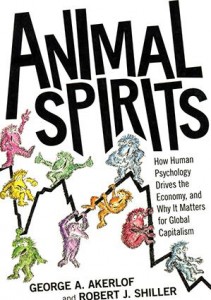 I confess that I dissected the form on my own, constructing worksheets with the details provided therein. It was a labor-intensive task, and I later discovered that I could have merely copied what others had done before me. However, in my more generous moments, I will admit that I learned much more about Yellen, her financial circumstances, and U.S. OGE forms by doing it on my own (compared with merely reading what others had prepared).
I confess that I dissected the form on my own, constructing worksheets with the details provided therein. It was a labor-intensive task, and I later discovered that I could have merely copied what others had done before me. However, in my more generous moments, I will admit that I learned much more about Yellen, her financial circumstances, and U.S. OGE forms by doing it on my own (compared with merely reading what others had prepared).
Within the report itself, her investment and asset value at the end of 2012 stood somewhere between the range of $4,749,000 and $12,885,000. As you’ll soon see, the actual value can be more precisely pegged than that!
One intriguing income source for Yellen/Akerlof is royalties from book sales! As you can see below, the OGE form asks for the description of an asset, its current “value”, and an estimate of current annual income from said asset. Below is listed four books written by one or both of the professors (only one of which is currently generating significant annual income). It also (interestingly) reports a Stamp Collection (worth as much as $50,000)! [4]
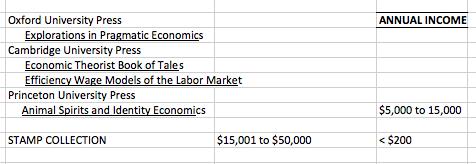 Another interesting sidelight of the “financial side” of the Yellen/Akerlof marriage is the potential for earning fees in return for speeches and/or serving as a consultant. As you see below, 2012 brought in at least $9,500 from such fees:
Another interesting sidelight of the “financial side” of the Yellen/Akerlof marriage is the potential for earning fees in return for speeches and/or serving as a consultant. As you see below, 2012 brought in at least $9,500 from such fees:
 However, as we recently saw in the life of now retired Federal Reserve Chair, Ben Bernanke, the “serious” money will come once Yellen retires as Fed Chair and becomes available for speech-making! In recent weeks, Bernanke earned $250,000 for a 40-minute speech[5] – almost 25% more money than he earned as Fed Chair during 2013!! That is incredible!
However, as we recently saw in the life of now retired Federal Reserve Chair, Ben Bernanke, the “serious” money will come once Yellen retires as Fed Chair and becomes available for speech-making! In recent weeks, Bernanke earned $250,000 for a 40-minute speech[5] – almost 25% more money than he earned as Fed Chair during 2013!! That is incredible!
In addition, the disclosure form reveals key “future streams of income” in the form of vested retirement benefits that will be due to Yellen/Akerlof once they officially retire:
There are four main “take aways” from the above worksheet:
1) Although the “principal value” of several of these benefits is listed as “Value not readily ascertainable”[6], the Present Value (PV) of such benefits is reported… as appears above.;
2) Take a close look at the benefit resulting for serving as President of the Federal Reserve Bank of San Francisco! She will receive 24% of her salary earned while serving. That salary exceeded $350,000…
3) Note that Yellen therefore earned 74% more as President of the San Francisco Fed than she will earn in 2014 as Chair (Fed Chair salary is set by Congress at the level of a Cabinet Secretary: $201,700);
4) Finally, the PV of vested pension benefits, excluding any/all existing assets in non tax-qualified accounts, is over $350,000/year! I presume that exceeds the vested annual pension income of 98% of those who will read this! Even at that, one speech following her retirement as Chair could almost match that!
Moving on to the strictly “investable assets” portion of the disclosure form, here is a listing of the common stocks held by Yellen/Akerlof at the time the Form 278 was submitted. Allow me to explain the key assumption made in the creation of this listing:
1) I assumed that the “actual” balance owned at the time of the report fell at the approximate “mid point” of the range:
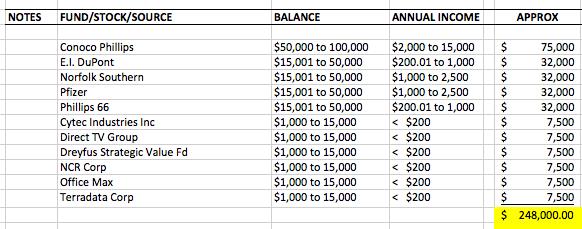 Take note of the fact that, except for the Dreyfus Strategic Value Fund (DAGVX), each of the above represents stock of a company: two oil companies, two chemical companies, a railroad, a pharmaceutical company, a satellite broadcast provider, two “computer related tech” companies, and an office products company that was bought out by Office Depot (ODP) in late 2013.[7] In the aggregate, these assets were then worth almost one quarter million dollars.
Take note of the fact that, except for the Dreyfus Strategic Value Fund (DAGVX), each of the above represents stock of a company: two oil companies, two chemical companies, a railroad, a pharmaceutical company, a satellite broadcast provider, two “computer related tech” companies, and an office products company that was bought out by Office Depot (ODP) in late 2013.[7] In the aggregate, these assets were then worth almost one quarter million dollars.
Next, we have a listing of holdings in mutual funds:[8]
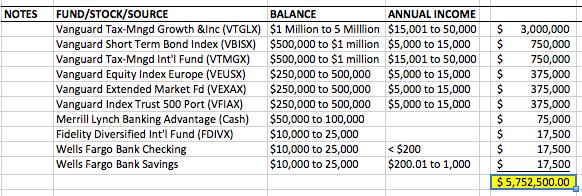 What general observations can we make about Yellen’s investment approach?
What general observations can we make about Yellen’s investment approach?
Here is a snapshot of the asset allocation suggested through the Form 278 Disclosure Report:
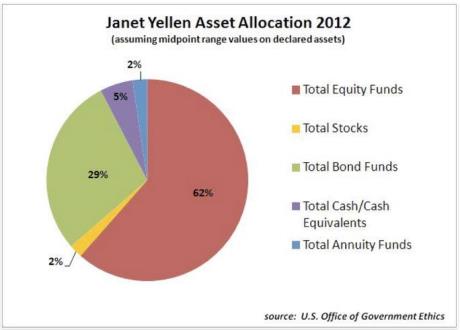
As you can see, it shapes up quite similar to the allocation found in the standard/”classic” “Balanced Fund” style (ie. 60% equity; remainder in bonds, cash, etc.).
We also notice immediately that her stock selections are in no way “exotic” or among the “hot stocks” list from which day traders most frequently pick for trades.[9]
Take a look at the following information:[10]
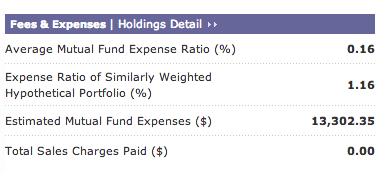 We see at least the following characteristics in these slides:
We see at least the following characteristics in these slides:
1) It is non-diversified in terms of geography – 94.5% of the portfolio is invested within the U.S. or Europe;
2) A middle of the road P/E valuation. Not super cheap; but in no way demonstrating overvaluation!
3) It generates a yield just over 2%;
4) Although the average market cap does not match the capitalization of the average S&P 500 stock, it is definitely not skewed toward midcaps or small caps.
5) She is quite fond of the no-load, low cost funds – primarily Vanguard, but also including Fidelity!
6) Interestingly, she owns absolutely no ETFs!! Within comparable asset classes, ETFs are generally even less expensive than funds!
With regard to portfolio management, there are some restrictions placed upon Yellen above and beyond the obvious desire to avoid having her portfolio ever become a matter of public debate.[11] One particular restriction bears emphasis here: Federal Reserve rules prohibit Yellen from buying or selling securities during the seven days prior to a meeting of the Fed's Federal Open Market Committee. In addition, she cannot hold a security for fewer than 30 days.[12] No day trading for Dr. Yellen or Dr. Akerlof!
Let’s assume that the Yellen/Akerlof portfolio was maintained throughout 2013.[13] How did it perform during the year? Below are some price charts comparing various holdings with the S&P 500 Index (red).
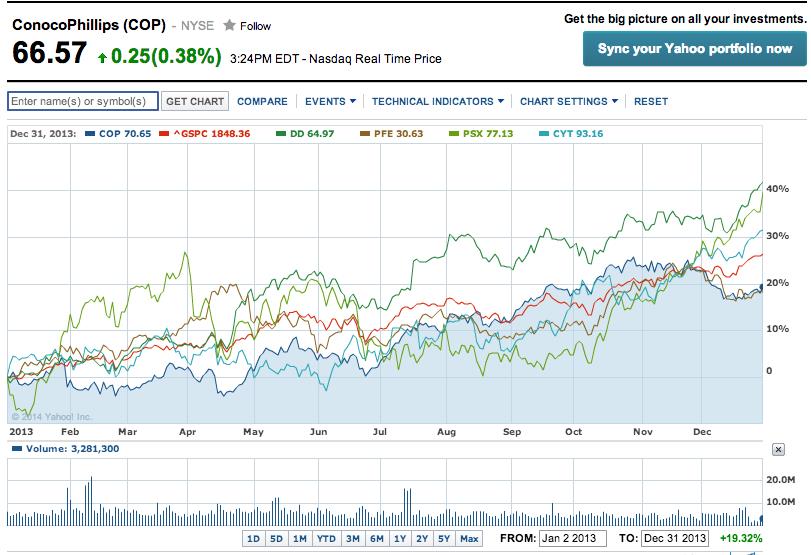 In the first group of Yellen Stocks, the Index outperformed COP and PFE… but underperformed DD, PSX, and CYT (in that order).
In the first group of Yellen Stocks, the Index outperformed COP and PFE… but underperformed DD, PSX, and CYT (in that order).
In the second group of Yellen stocks, the Index significantly outperformed TDC[14], performed in line with DAGVX, and slightly lagged DTV and NCR.
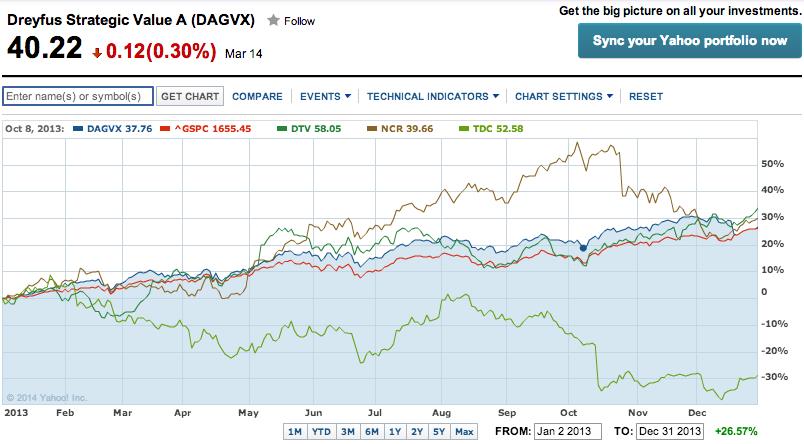 Looking at the chart of Yellen funds, the Index significantly underperformed VEXAX (extended market), performed in line (as expected) with VTGLX and VFIAX, and outperformed the remaining funds.[15]
Looking at the chart of Yellen funds, the Index significantly underperformed VEXAX (extended market), performed in line (as expected) with VTGLX and VFIAX, and outperformed the remaining funds.[15]
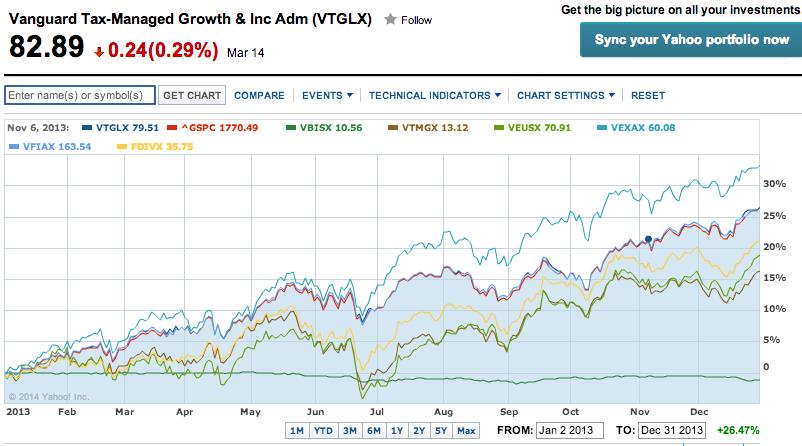 So overall, Yellen/Akerlof did not “burn up” the market, nor did their portfolio embarrass them. It largely accomplished their likely investment goal – Growth with Managed Risk.
So overall, Yellen/Akerlof did not “burn up” the market, nor did their portfolio embarrass them. It largely accomplished their likely investment goal – Growth with Managed Risk.
Given the 2013 returns I uncovered for each investment vehicle above, here is what the portfolio would have looked like at the end of 2013:

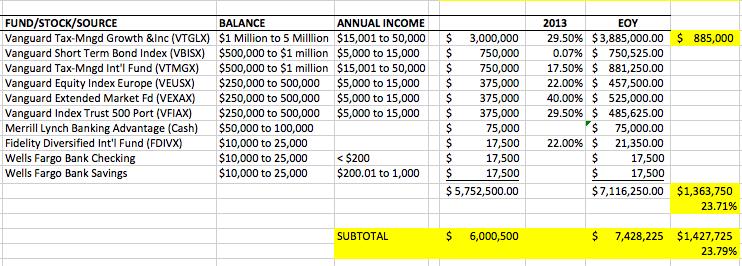 Is there any further insight we can identify with regard to the Yellen/Akerlof portfolio? It clearly suffers from a shortcoming that is common within the portfolios of millions of U.S. investors: the various investment vehicles within the portfolio are too highly correlated!
Is there any further insight we can identify with regard to the Yellen/Akerlof portfolio? It clearly suffers from a shortcoming that is common within the portfolios of millions of U.S. investors: the various investment vehicles within the portfolio are too highly correlated!
Let me try to explain what I mean. Far too many persons assume that diversification can be achieved by spreading one’s investment capital among a number of different stocks, mutual funds, or ETFs. There is no question that effective diversification can be achieved through an optimized set of stocks, ETFs, or funds. However, consider for a moment (as an example) these three theoretical portfolios:
 Obviously, the portfolio to the far left is the stock portion of the Yellen/Akerlof portfolio. We’ve already identified how concentrated it is within North American companies, as well as the fact that it is relatively “Large Cap” in size. The portfolio to the far right is about the “largest” U.S. “Large Cap” group of U.S. stocks you could own – consisting as it does of the nine U.S. stocks with the largest market capitalization! With regard to the portfolio in the middle… just imagine for one moment owning that portfolio! Here is a 2013 price graph of seven of those stocks compared with the S&P 500 Index.[16]
Obviously, the portfolio to the far left is the stock portion of the Yellen/Akerlof portfolio. We’ve already identified how concentrated it is within North American companies, as well as the fact that it is relatively “Large Cap” in size. The portfolio to the far right is about the “largest” U.S. “Large Cap” group of U.S. stocks you could own – consisting as it does of the nine U.S. stocks with the largest market capitalization! With regard to the portfolio in the middle… just imagine for one moment owning that portfolio! Here is a 2013 price graph of seven of those stocks compared with the S&P 500 Index.[16]
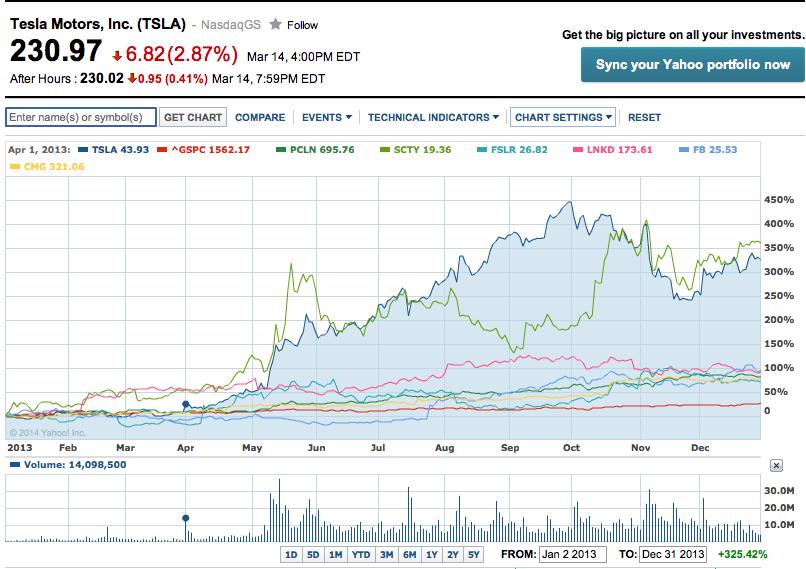 Components within this portfolio share two characteristics:
Components within this portfolio share two characteristics:
1) Each stock handily outperformed the Index during 2013;
2) Health insurance policies contain an “exclusion clase” regarding mental health care for any policy-holder who owns that portfolio!! (I am just kidding – but most folks could not bear with the daily volatility within such a portfolio!)
By the way, the massive volatility of Tesla (TSLA) and SolarCity (SCTY) so effectively overwhelms the volatility of the other components that I prepared a separate graph showing this portfolio without those two stocks! Now you can see how these “tamer” stocks, in their own right, could cause severe hypertension on any given day! (I added GOOG back, and added in TWTR… quite volatile following the IPO).
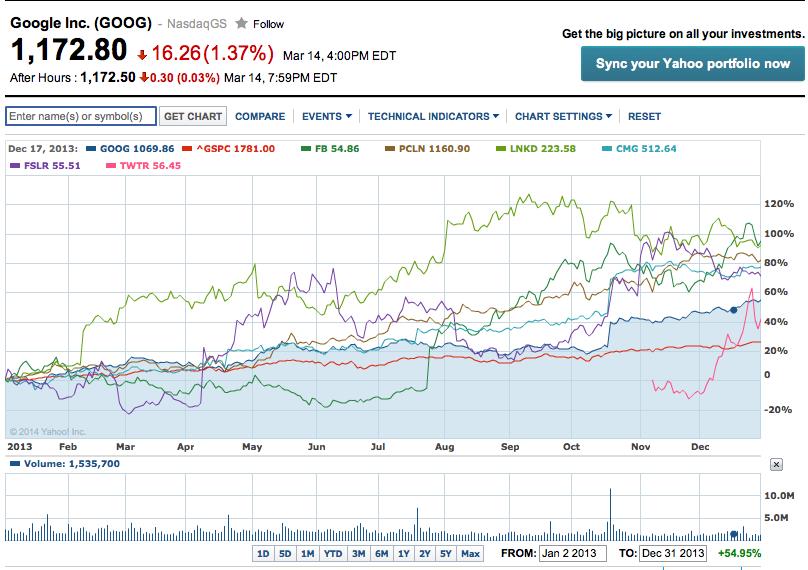 So the plain and simple truth is that none of these three portfolios provides adequate diversification or risk management! Yes, each portfolio contains ten stocks from various industries, but each component within the portfolio is more highly correlated with the other components than is optimal!
So the plain and simple truth is that none of these three portfolios provides adequate diversification or risk management! Yes, each portfolio contains ten stocks from various industries, but each component within the portfolio is more highly correlated with the other components than is optimal!
In its simplest form, correlation is a mathematical measure of how the returns of two separate investment vehicles move relative to one another, including:
1) Do the returns move in the same direction, or the opposite direction?
2) How much do they move in any direction, and what is the magnitude of similarity or difference between returns?
Obviously, correlation is calculated using historical returns. If the returns are more similar, the Correlation Index is closer to +1.0; if the returns are quite different, the Correlation Index is closer to -1.0. In any event, the Correlation Index is a number between +1.0 and -1.0!
Let’s take another look at a portion of one of our earlier graphs – comparing TSLA, SCTY, and the S&P 500 Index:
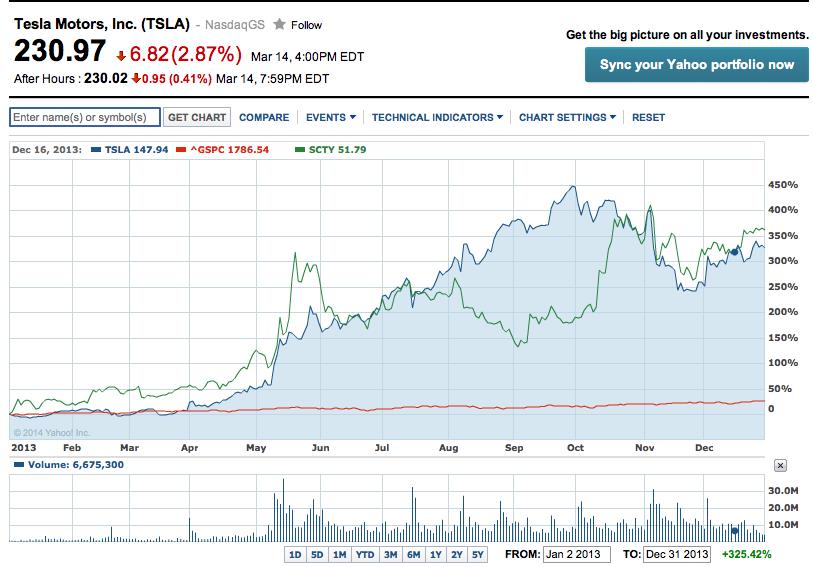 We can see that these two “Alternative Energy” plays are more highly correlated with one another than with the Index! The Correlation Index between TSLA and SCTY would be closer to +1.0… far higher than the Correlation Index of either compared with the Index!
We can see that these two “Alternative Energy” plays are more highly correlated with one another than with the Index! The Correlation Index between TSLA and SCTY would be closer to +1.0… far higher than the Correlation Index of either compared with the Index!
Now consider the following graph comparing the Index (represented by SPY… in blue) with the Gold ETF (GLD) in red.
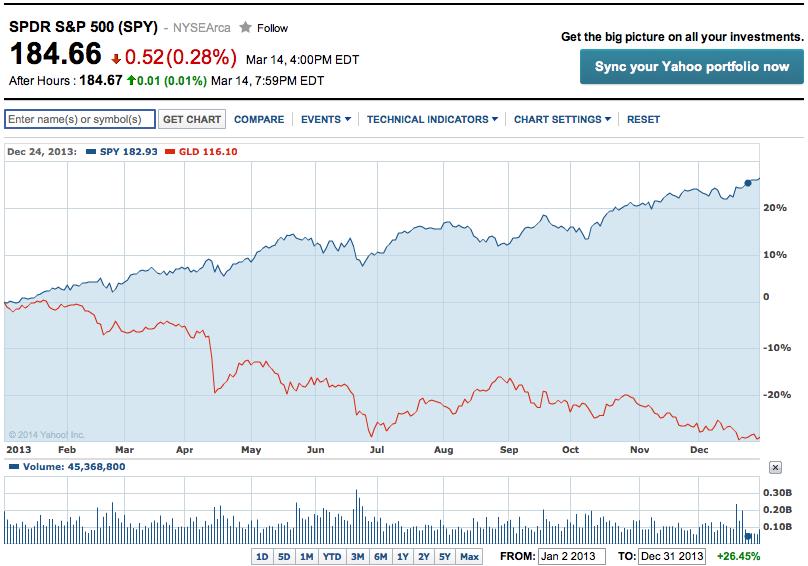 They move in opposite directions, so the Correlation Index would be closer to -1.0.
They move in opposite directions, so the Correlation Index would be closer to -1.0.
A similar (but not as dramatic) relationship can be seen between SPY and the U.S. Bond Market (represented below by the iShares Core Total U.S. Bond Market ETF (AGG):
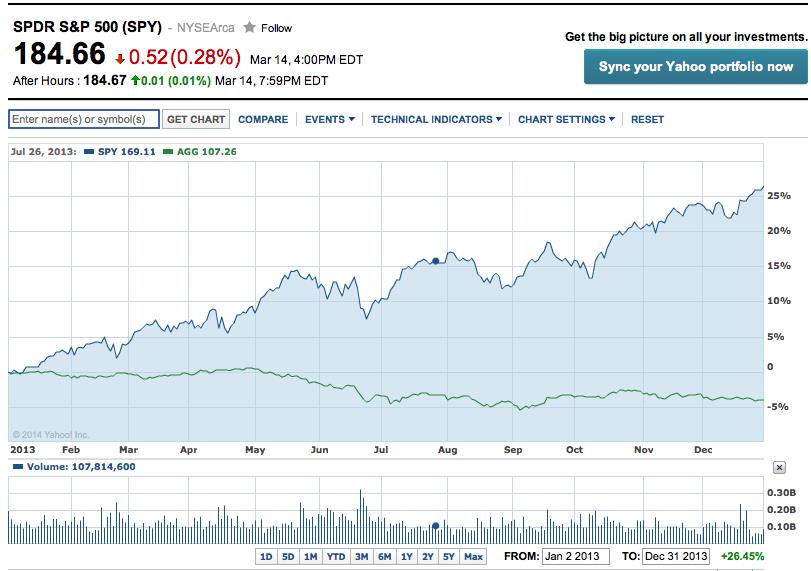 What would you guess might be the Correlation Index between stocks and bonds?
What would you guess might be the Correlation Index between stocks and bonds?
When designing a portfolio, financial experts try to produce a portfolio that fits the risk profile of the “owner”. If that owner is still in her/his 20-30’s, the portfolio can be more aggressive – including a few appropriate TSLA-like stocks. However, if the owner is in his/her 50-60’s and preparing for retirement, the portfolio needs to be well balanced and less volatile. However, in neither case should the portfolio consist entirely of assets that are highly correlated with one another!
When an investor becomes familiar with and knowledgeable about a wide range of asset “classes”, a much more effective, more diversified (ie. less correlated), and more profitable portfolio can be constructed! Here are some of the asset classes from which one can choose:
 It has become established in study after study that the construction of a diversified portfolio that contains an asset mix with (relatively) “low correlation” will most likely lead to an aggregate investment return that will do one of two things: 1) result in a return that is higher, without the need to take any additional risk; or 2) result in a return which is comparable, but at a much lower level of risk!
It has become established in study after study that the construction of a diversified portfolio that contains an asset mix with (relatively) “low correlation” will most likely lead to an aggregate investment return that will do one of two things: 1) result in a return that is higher, without the need to take any additional risk; or 2) result in a return which is comparable, but at a much lower level of risk!
This very point is crucial whenever you seek out education on investments and trading! Any trainer or educator can entice you with extremely attractive levels of potential return. The truly important question to be answered before you invest any money using any particular methodology is – “What is the level of risk I am assuming in order to achieve that potential rate of return?” It is for this reason that one of the most invaluable metrics you will ever have when considering investment options is “Risk Adjusted Return.”[17]
The list of potential asset classes provided above just scratches the surface.[18] I cannot possibly emphasize enough how much easier it is for today’s investor to own an “optimized” portfolio! Back in “my day” (I started investing in the 1970’s), commissions were outrageous, international bonds were less accessible, “round lots” (100 shares) were the most common “unit” of trade, and becoming “broadly diversified” was a journey!
In sharp contrast, the emergence and maturity of ETFs (extremely affordable baskets of securities within any given asset class) has made it possible for any investor with even a modest-sized portfolio to become “instantly” diversified to a degree I could never have dreamed of in the 1970’s!
Let me wrap up by offering some data derived from our all too recent brush with a Big Bear Market – namely, the period between September of 2008 and February of 2009. One of the vivid memories I still hold from that period is how horribly widespread the carnage was within investment markets! There were few places for one to “run and hide”!
I learned an unwanted lesson about “correlation” in that market! When it feels as though (to use Baron Rothschild’s old term) “there is blood in the streets”, all assets become significantly more highly correlated!! In other words, the benefit from diversification is considerably weakened because “everyone is selling… and asking questions later”! Look at this chart from Fidelity Investments showing the correlation to US Stocks of various asset classes:
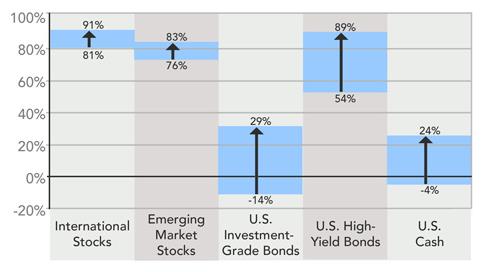 What this means is that, during the Crisis Period, the correlation to US Stocks of International Stocks increased from .81 to .91; Emerging Market Stocks from .76 to .83; US Investment Grade Bonds from a -.14 to a +.29 (that was a huge swing!!); and so forth!
What this means is that, during the Crisis Period, the correlation to US Stocks of International Stocks increased from .81 to .91; Emerging Market Stocks from .76 to .83; US Investment Grade Bonds from a -.14 to a +.29 (that was a huge swing!!); and so forth!
Notice that even “Cash” became more highly correlated!
Does that mean that diversification suddenly lost its “power”? Absolutely not! It may have “felt” as though that is what happened… but look at this chart of the respective portfolio returns from January 2008 through April 2013:[19]
 As you can see, for those with a “Warren Buffettesque” will power to “stay the course” during times of trouble, diversification will (ultimately) lead you back from the arid, desert regions of Crisis into sweet, lush, green regions that flow with milk, honey, profits… and maybe even a Tesla Model S, if you are very, very good!
As you can see, for those with a “Warren Buffettesque” will power to “stay the course” during times of trouble, diversification will (ultimately) lead you back from the arid, desert regions of Crisis into sweet, lush, green regions that flow with milk, honey, profits… and maybe even a Tesla Model S, if you are very, very good!
INVESTOR TAKEAWAY: Laying aside for a moment the reality that Drs. Yellen and Akerlof are not exactly highly motivated investors[20], their US OGE Form 278 has afforded us a glimpse of what life might look like to a highly accomplished couple who have straddled the realms of Academia and Government Service!
In addition, their middle of the road portfolio has provided a “jumping off point” for an extended discussion regarding asset allocation, diversification, correlation, and the importance of “Risk-adjusted Return”! They have made masterful use of inexpensive, no-load, low fee funds! But they have ignored the investment principles of diversification among asset classes, making full use of the investment opportunities inherent in our global economy, and optimizing investment correlation.
Two other anomalies within the Yellen/Akerlof Portfolio should not be passed over without comment:
1) There is absolutely no ETF within the mix!
a. That is surprising, since within most asset classes, there is an ETF that is even cheaper (fee-wise) than most comparable funds!
b. ETFs now make it possible to construct, on a historically cheap basis, a portfolio that is optimized for diversification (and correlation) in order to produce the best “Risk-adjusted Return”.
2) Very related to 1) above[21] is the fact that, among High Net Worth (HNW) Investors[22], “Alternative Assets” are becoming increasingly prevalent! However, opening that “Pandora’s Box” will need to wait for another day – perhaps far into the future
DISCLOSURE: I regret to say that I am not an heir of either Chairman Yellen or Dr. Akerlof! Neither am I currently a shareholder within any of the stocks they owned as of the time of their Form 278 Disclosure! However, I do own a number of Vanguard and Fidelity Funds, for many of the same reasons they do. In addition, at various points I have owned stock in, or options related to, TSLA, SCTY, GOOG, IBM, TWTR, PCLN, WMT, CMG, NSC, COP, PSX, AAPL, GE, BRK-B.
Nothing in this article is intended as a recommendation to buy or sell anything. Always consult with your financial advisor regarding changes in your portfolio – either subtractions or additions.
[1] Many would assert that the form contains an oxymoron… pairing “Ethics” with “Covernment”.
[2] An early FULL DISCLOSURE: the information provided in the report was already old when it was released in 2013 (compiled in late 2012). In addition, the form only requires providing ranges for asset values. Therefore, everything I write about her portfolio is based on assumptions, including the following: a) The portfolio was maintained unchanged through 2013 (unlikely); b) the actual value of each asset at the start of 2013 fell at the “midrange” point reported. Needless to say, that makes my conjectures arbitrary and hypothetical! It is presented for instructional purposes only and NEVER referred to as her actual current portfolio!!
[3] Find it at http://online.wsj.com/public/resources/documents/Yellen-finrpt2010.pdf
[4] If anyone can inform me how a stamp collection generates any income to the owner (other than through a sale), I’d be grateful! Up to $200 is reported on the form as “annual income”.
[5] He spoke at the Global Financial Markets Forum (in Abu Dhabi) on March 4
[6] No one is evading disclosure by describing the value in those terms. The OGE Form 278 includes that phrase as a legitimate response!
[7] Office Max shareholders received 2.69 Office Depot (ODP) shares for each old share of Office Max held at the time of merger.
[8] It is a mystery to me why DAGVX was not included in this list instead of among the stocks!
[9] This should not come as any surprise to anyone, by the way. Yellen doesn’t have time to devote to the daily gyrations of a TSLA, GOOG, CMG, PCLN, or PLUG.
[10] All data in these three slides are derived from the Morningstar “X-Ray” tool!
[11] I refer, of course, to the strong preference to never be found owning a stock that suddenly rapidly appreciates in price due to a government regulator’s decision, a Federal loan, a huge government contract, or any other major government-related news!
[12] Except for shares of a money-market fund!
[13] Excluding the Office Max shares, which (as alluded to earlier) merged into ODP. I could not find dependable figures for 2013 appreciation. However, the total value of the shares was immaterial for this purpose.
[14] TDC was down 30% in 2013.
[15] Obviously, the Short-Term Bond Fund is in the mix as a source of income and as a tool for risk management (very similar to “Cash”).
[16] I exclude Google (GOOG) because it was “relatively” boring… and Twitter (TWTR) because the IPO did not occur until November!
[17] Simply a measure of any given “Return” relative to the units of “Risk” required to achieve said return!!
[18] For example, in “International Bonds”, you can own such bonds that are “US Dollar denominated” or that are based on the foreign currency of the respective bond issuer (such as EURO, YEN, Ruble, etc.).
[19] This chart was provided by Strategic Advisers, Inc.
[20] Most of us would be tempted to retire right now if we were blessed with their current assets and vested future stream of pension benefits!
[21] There are a growing number of ETFs that offer one form or another of “Alternative Assets” – namely, investment instruments specifically tailored to be un-correlated or non-correlated with equities!
[22] The Yellen/Akerlof financial circumstance more than qualifies to be considered in the “HNW” category!
Related Posts
Also on Market Tamer…
Follow Us on Facebook


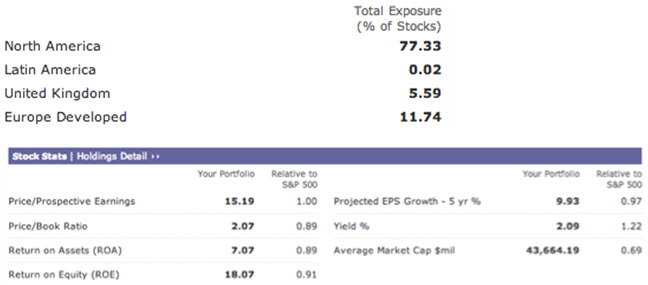
 Why Shares in Caterpillar Tracked Lower Again Today
Why Shares in Caterpillar Tracked Lower Again Today
